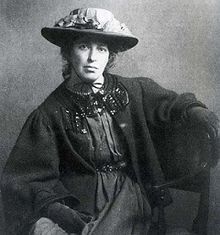Jessie Newbery
| Jessie Newbery | |
|---|---|
 |
|
| Born |
Jessie Wylie Rowat 28 May 1864 Paisley |
| Died | 27 April 1948 (aged 83) Dorset |
| Nationality | Scottish |
| Education | Glasgow School of Art |
| Known for | Decorative Arts, Design |
| Movement | Art Nouveau, Glasgow Style, Symbolism |
| Spouse(s) | Francis Newbery |
Jessie Newbery (28 May 1864 – 27 April 1948) was a Scottish artist and embroiderer. She was one of the artists known as the Glasgow Girls. Newbery also created the Department of Embroidery at the Glasgow School of Art where she was able to establish needlework as a form of unique artistic design. She married director of the Glasgow School of Art, Francis Newbery, in 1889.
Born Jessie Wylie Rowat in Paisley, she was the daughter of Margaret Downie Hill and William Rowat, a forward-thinking shawl manufacturer. A visit to Italy when Newbery was eighteen stimulated a lifelong interest in textiles and other decorative arts. She enrolled as a student at Glasgow School of Art in 1884.
Newbery established the Department of Embroidery at the Glasgow School of Art and she was appointed head in 1894. Newbery was considered an "enthusiastic teacher and encouraged a strong sense of design in her pupils' work." Her work in the Department of Embroidery helped to raise the status of creative needlework.
Newbery felt that design, in addition to utility, was important in her work. A rose motif, made using circular pink linen applied to the support with a silk satin stitch, frequently appears in her work and came to be seen as a kind of trademark. While the symbol has been interpreted as feminine, mystical, as well as symbolic of female genitalia, such an analysis has been said to underestimate "Newbery's materialism, her commitment to socialism and her contribution to community." Her approach to design was egalitarian: "I believe that nothing is common or unclean: that the design and decoration of a pepper pot is as important in its degree, as the conception of a cathedral."
Newbery was careful in her choice of color and materials. She preferred to use a lighter palette than was traditional, focusing on light purples, greens, blues and pink. She also encouraged the use of "unusual techniques such as needle weaving." Newbery's appliqué work gave rise to the rose motif identified with Glasgow Style, Charles Rennie Mackintosh and his circle.
She taught dress design alongside embroidery. She thought clothing should be practical and took an interest in rational dress, while also believing that clothes should be beautiful. This approach to women's clothing was considered "avant-garde" and "radical." Newbery first experimented with a "Renaissance flavor" in her own clothing, often choosing materials such as silk velvets and lightweight wools which she embroidered herself. Additionally, she held classes in mosaics, from 1896 to 1898, in enamels from 1895 to 1899, and also in book decoration in 1899.
...
Wikipedia
